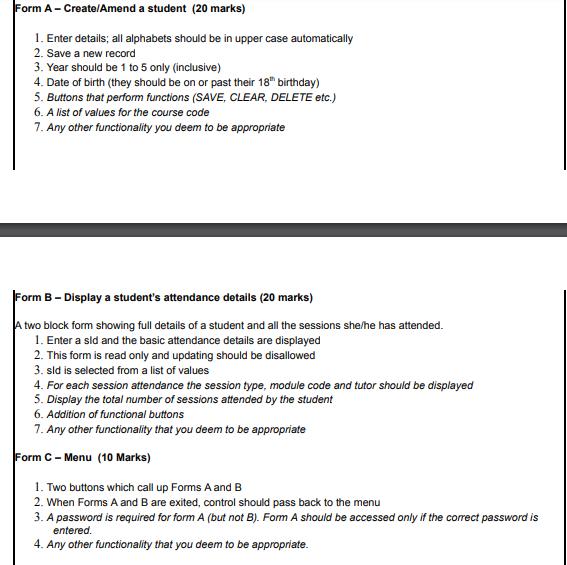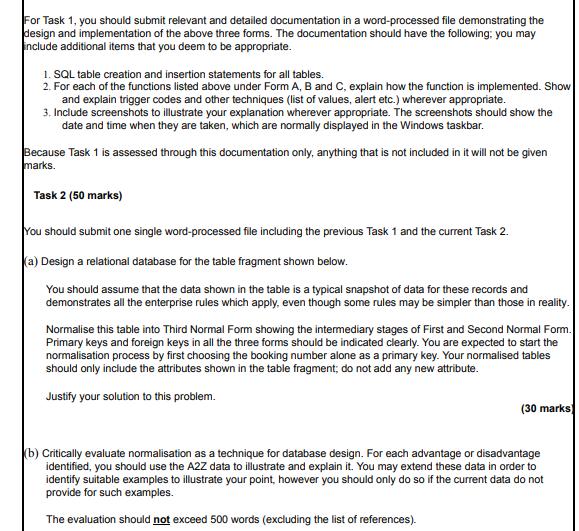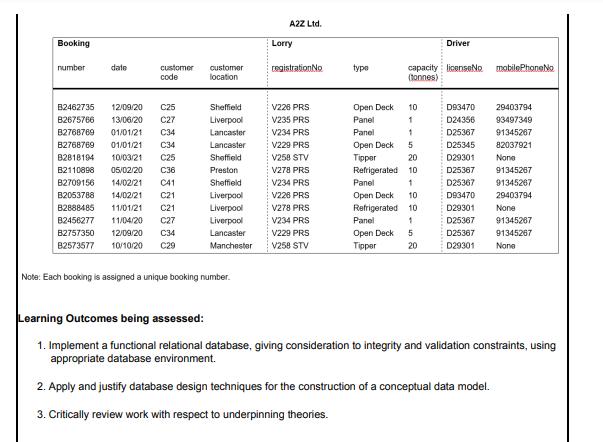Answered step by step
Verified Expert Solution
Question
1 Approved Answer
Use Oracle Forms to create a database application. This application is based on the following table types, with primary keys underlined and foreign keys




Use Oracle Forms to create a database application. This application is based on the following table types, with primary keys underlined and foreign keys in italics: Student (sld, surname, forenames, address, mobile Phone, cCode, cYear, dob) Sessions (sCode, sType, mCode, tutor, SDT, EDT, Room) Attendance (aNo, sld, sCode, CSDT) Student sid surname forenames address mobilePhone cCode cYear dob Sessions sCode SType mCode tutor SDT EDT Room Attendance aNo sld sCode CSDT 17 char maximum (e.g. Johnson B) 15 char maximum 15 char maximum 50 char maximum 11 digit number (e.g. 07654321234) 7 char (e.g. COMP101) 1 digit number (range 1,2,3,4,5) date number (3 digits) Lecture, Lab, Tutorial, Seminar 6 char maximum (e.g. CO4703) 20 char maximum date date 10 char maximum (e.g. CM210) number (5 digits) 17 char maximum number (3 digits) date (student ID) (course code) (course year) (date of birth) (session code) (session type) (module code) (tutor name) (start date and time) (end date and time) (date and time of card scanning) You are expected to create these tables using SQL and then populate them with appropriate and sufficient test data of your own (hint: use varchar2 for sld and also for all variable length character strings). To gain a pass mark for Task 1 you will achieve basic functionality for forms A, B and C as outlined below. To gain higher marks you will create a more user-friendly interface (e.g. good screen layout, appropriate use of colours, use of buttons, clear messages), and will achieve the functionality as italicised for each form. Form A-Create/Amend a student (20 marks) 1. Enter details; all alphabets should be in upper case automatically 2. Save a new record 3. Year should be 1 to 5 only (inclusive) 4. Date of birth (they should be on or past their 18th birthday) 5. Buttons that perform functions (SAVE, CLEAR, DELETE etc.) 6. A list of values for the course code 7. Any other functionality you deem to be appropriate Form B-Display a student's attendance details (20 marks) A two block form showing full details of a student and all the sessions she/he has attended. 1. Enter a sld and the basic attendance details are displayed 2. This form is read only and updating should be disallowed 3. sld is selected from a list of values 4. For each session attendance the session type, module code and tutor should be displayed 5. Display the total number of sessions attended by the student 6. Addition of functional buttons 7. Any other functionality that you deem to be appropriate Form C-Menu (10 Marks) 1. Two buttons which call up Forms A and B 2. When Forms A and B are exited, control should pass back to the menu 3. A password is required for form A (but not B). Form A should be accessed only if the correct password is entered. 4. Any other functionality that you deem to be appropriate. For Task 1, you should submit relevant and detailed documentation in a word-processed file demonstrating the design and implementation of the above three forms. The documentation should have the following: you may include additional items that you deem to be appropriate. 1. SQL table creation and insertion statements for all tables. 2. For each of the functions listed above under Form A, B and C, explain how the function is implemented. Show and explain trigger codes and other techniques (list of values, alert etc.) wherever appropriate. 3. Include screenshots to illustrate your explanation wherever appropriate. The screenshots should show the date and time when they are taken, which are normally displayed in the Windows taskbar. Because Task 1 is assessed through this documentation only, anything that is not included in it will not be given marks. Task 2 (50 marks) You should submit one single word-processed file including the previous Task 1 and the current Task 2. (a) Design a relational database for the table fragment shown below. You should assume that the data shown in the table is a typical snapshot of data for these records and demonstrates all the enterprise rules which apply, even though some rules may be simpler than those in reality. Normalise this table into Third Normal Form showing the intermediary stages of First and Second Normal Form. Primary keys and foreign keys in all the three forms should be indicated clearly. You are expected to start the normalisation process by first choosing the booking number alone as a primary key. Your normalised tables should only include the attributes shown in the table fragment; do not add any new attribute. Justify your solution to this problem. (30 marks) (b) Critically evaluate normalisation as a technique for database design. For each advantage or disadvantage identified, you should use the A2Z data to illustrate and explain it. You may extend these data in order to identify suitable examples to illustrate your point, however you should only do so if the current data do not provide for such examples. The evaluation should not exceed 500 words (excluding the list of references). Booking number date customer customer code location B2462735 12/09/20 C25 B2675766 13/06/20 C27 B2768769 01/01/21 C34 B2768769 01/01/21 C34 82818194 10/03/21 C25 B2110898 05/02/20 C36 B2709156 14/02/21 C41 B2053788 14/02/21 C21 B2888485 11/01/21 C21 B2456277 11/04/20 C27 B2757350 12/09/20 C34 82573577 10/10/20 C29 Sheffield Liverpool Lancaster Lancaster Sheffield Preston Sheffield Liverpool Liverpool Liverpool Lancaster Manchester Note: Each booking is assigned a unique booking number. A2Z Ltd. Lorry registration No V226 PRS V235 PRS V234 PRS V229 PRS V258 STV V278 PRS V234 PRS V228 PRS V278 PRS V234 PRS V229 PRS V258 STV type capacity licenseNo mobile PhoneNo (tonnes) Open Deck Panel Panel 20 Open Deck Tipper Refrigerated 10 Panel 1 Open Deck Refrigerated 10 Panel Open Deck Tipper 10 1 5 10 1 1 5 Driver 20 D93470 29403794 D24356 93497349 D25367 91345267 D25345 82037921 D29301 None D25367 91345267 D25367 91345267 D93470 29403794 D29301 None D25367 91345267 D25367 91345267 D29301 None Learning Outcomes being assessed: 1. Implement a functional relational database, giving consideration to integrity and validation constraints, using appropriate database environment. 2. Apply and justify database design techniques for the construction of a conceptual data model. 3. Critically review work with respect to underpinning theories.
Step by Step Solution
There are 3 Steps involved in it
Step: 1

Get Instant Access to Expert-Tailored Solutions
See step-by-step solutions with expert insights and AI powered tools for academic success
Step: 2

Step: 3

Ace Your Homework with AI
Get the answers you need in no time with our AI-driven, step-by-step assistance
Get Started


